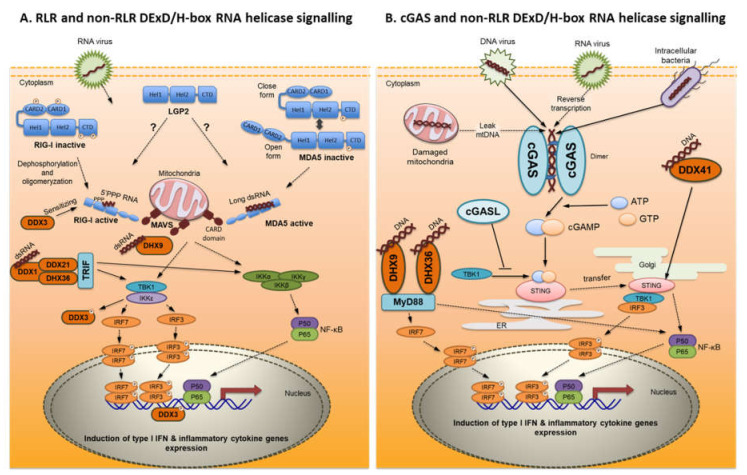Figure 1.
RLR (A), cGAS-STING (B) and non-RLR DExD/H-box RNA helicases (A,B) pathways detect cytoplasmic nucleic acids and activate type I IFN and pro-inflammatory cytokines. Dotted lines represents pathways confirmed in fish. (A) RIG-I and MDA5 upon binding of viral RNA induce signal transduction in MAVS-dependent manner leading to the induction of the expression of type I IFNs and pro-inflammatory cytokines. LGP2 does not possess signaling CARD domains and its role in the mediating of antiviral response is unclear. LGP2 receptor has been shown to function as a positive or negative regulator of RLR-mediated signaling. Viral RNA in cytoplasm is also recognized by non-RLR DExD/H-box RNA helicases: DDX3 has been proposed to sensitize RLR to sense viral RNA. It acts as a signaling intermediate downstream of TBK1 and IKKε and as a transcriptional regulator of the ifnb promoter. DHX9 was shown to sense dsRNA and to signal in a MAVS-dependent manner. A complex of DDX1-DDX21-DHX36 has been suggested to detect dsRNA and to signal in a TRIF-dependent manner. This leads to induction of the expression of type I IFNs and pro-inflammatory cytokines. (B) Upon recognition of virus or bacterial-derived DNA released into the cytoplasm, viral DNA synthesized by reverse transcription, and upon infection-induced mitochondrial dsDNA damaged and leaked cGAS synthesizes 2′3′-cGAMP. 2′3′-cGAMP binds to STING in the ER and causes its translocation to the Golgi system. STING activates TBK1-IRF3 and NF-κB and induces the production of type I IFNs and pro-inflammatory cytokines. DNA in cytoplasm is also recognized by non-RLR DExD/H-box RNA helicases: DDX41 upon binding of cytoplasmic DNA signals in a STING-dependent manner while DHX9 and DHX36 upon binding of cytoplasmic DNA signal in a MyD88-depending manner. This leads to induction of the expression of type I IFNs and pro-inflammatory cytokines.

